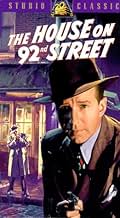IMDb-BEWERTUNG
6,6/10
3414
IHRE BEWERTUNG
Füge eine Handlung in deiner Sprache hinzuBill Dietrich becomes a double agent for the F.B.I. in a German spy ring.Bill Dietrich becomes a double agent for the F.B.I. in a German spy ring.Bill Dietrich becomes a double agent for the F.B.I. in a German spy ring.
- 1 Oscar gewonnen
- 4 wins total
William Post Jr.
- Walker
- (as William Post)
William Adams
- Customs Officer
- (Nicht genannt)
Frieda Altman
- Saboteur
- (Nicht genannt)
William Beach
- Saboteur
- (Nicht genannt)
Carl Benson
- German Spy Trainee
- (Nicht genannt)
Hamilton Benz
- Saboteur
- (Nicht genannt)
Ausgewählte Rezension
This is the story of how the FBI supposedly cracked a Nazi espionage ring on the trail of Manhattan Project (the A-Bomb) in the early years of World War II. As a movie, its chief significance is that it kicked off a spate of semi-documentary movies paying tribute to one or another of the U.S. government's law enforcement agencies and celebrating Our Tax Dollars at Work. Such films became a staple of the noir cycle; a few of them even achieved distinction (T-Men, for instance).
William Eythe, a young American, is recruited by and trained in Germany to be a spy; in fact he works as a double agent for the FBI. The film, shot largely on location, traces the actions of the nest of vipers on New York's upper east side. Their unofficial master seems to be Signe Hasso, under cover of running a chic dress boutique. Her opposite number, who runs Eythe, is Lloyd Nolan (who was to reprise his role as Inspector Briggs in subsequent films).
The film's period flavor keeps it from seeming too dated, because the spying looks quite primitive to audiences spoiled by James Bond gimmickry and later, even more sophisticated, espionage thrillers. And, from a modern perspective, the smug boastfulness about the Bureau's -- and America's -- infallibility becomes a bit hard to swallow. There's little texture or nuance in the film, but, as a quasi-historical document, it exerts its own fascination.
William Eythe, a young American, is recruited by and trained in Germany to be a spy; in fact he works as a double agent for the FBI. The film, shot largely on location, traces the actions of the nest of vipers on New York's upper east side. Their unofficial master seems to be Signe Hasso, under cover of running a chic dress boutique. Her opposite number, who runs Eythe, is Lloyd Nolan (who was to reprise his role as Inspector Briggs in subsequent films).
The film's period flavor keeps it from seeming too dated, because the spying looks quite primitive to audiences spoiled by James Bond gimmickry and later, even more sophisticated, espionage thrillers. And, from a modern perspective, the smug boastfulness about the Bureau's -- and America's -- infallibility becomes a bit hard to swallow. There's little texture or nuance in the film, but, as a quasi-historical document, it exerts its own fascination.
Handlung
WUSSTEST DU SCHON:
- WissenswertesThe movie deals with the theft by German spies of the fictional "Process 97", a secret formula which, the narrator tells us, "was crucial to the development of the atomic bomb." The movie was released on September 10, 1945, only a month after the atomic bombs had been dropped on Japan, and barely a week after Japan's formal surrender. While making the film, the actors and Director Henry Hathaway did not know that the atomic bomb existed, nor that it would be incorporated as a story element in the movie. (None of the actors in the film mentioned the atomic bomb.) However, co-Director and Producer Louis De Rochemont (who produced the "March of Time" newsreel films) and Narrator Reed Hadley were involved in producing government films on the development of the atomic bomb. (Hadley was present at the final test of the bomb in Los Alamos, New Mexico, in July, 1945.) After the bomb was dropped on Hiroshima, Hadley and Screenwriter John Monks, Jr. hastily wrote some additional voice-over narration linking "Process 97" to the atomic bomb, and Rochemont inserted it into the picture in time for the film's quick release.
- PatzerThe description of a one-way mirror as an "X-ray" mirror at the beginning is nonsense. A one-way mirror is in fact merely a partially-silvered mirror. It becomes "one-way" by virtue of different lighting on either side - one side dimly lit, the other brightly lit. From the side that's brightly lit, it appears to be a normal mirror because the reflection washes out any light coming through from the dim side. But from within the dim side, everything on the bright side is readily visible because the light coming through predominates over the reflection seen from the dim side.
- Zitate
Agent George A. Briggs: We know all about you, Roper. We've traced you to the day you were born. We even know the approximate day you will die.
- Crazy CreditsOpening credits are shown as someone flipping through the pages of a file.
- VerbindungenReferenced in 23 Schritte zum Abgrund (1956)
- SoundtracksTra-La-La-La
(uncredited)
Music by Harry Warren
Played as background music at the talent agent's office
Top-Auswahl
Melde dich zum Bewerten an und greife auf die Watchlist für personalisierte Empfehlungen zu.
- How long is The House on 92nd Street?Powered by Alexa
Details
- Erscheinungsdatum
- Herkunftsland
- Sprachen
- Auch bekannt als
- The House on 92nd Street
- Drehorte
- Hamburg, Deutschland(second unit)
- Produktionsfirma
- Weitere beteiligte Unternehmen bei IMDbPro anzeigen
Box Office
- Bruttoertrag in den USA und Kanada
- 2.500.000 $
- Laufzeit1 Stunde 28 Minuten
- Farbe
- Seitenverhältnis
- 1.37 : 1
Zu dieser Seite beitragen
Bearbeitung vorschlagen oder fehlenden Inhalt hinzufügen

Oberste Lücke
By what name was Das Haus in der 92. Straße (1945) officially released in India in English?
Antwort





























